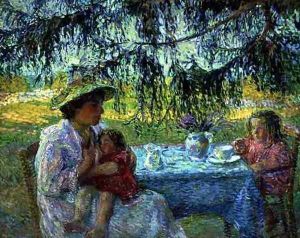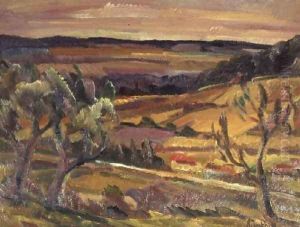Alexandrovitch Tarkhoff Paintings
Nikolai Alexandrovitch Tarkhoff was born in 1872 in Moscow, Russia, into a family of moderate means. His early life did not immediately point towards an artistic career, but Tarkhoff was drawn to the arts from a young age. Despite the lack of a formal art education in his early years, his passion for painting led him to pursue a career in art, a decision that would see him leave Russia to further his studies and career in Europe, a common move among many Russian artists of his time seeking artistic freedom and new influences.
Tarkhoff's journey into the arts formally began when he moved to Paris in the late 19th century, a city that was then the heart of the art world. Paris offered him the vibrant artistic community and the exposure to the avant-garde movements that were to influence his work profoundly. He was particularly drawn to the Impressionists, whose revolutionary approach to color and light would leave a lasting impact on his style. Tarkhoff absorbed these new ideas while developing a distinctive style that balanced between Impressionism and Post-Impressionism, characterized by vibrant colors, dynamic brushstrokes, and a deep sensitivity to the atmospheric qualities of his subjects.
Throughout his career, Tarkhoff exhibited a profound fascination with the ordinary moments of daily life, often painting urban scenes, landscapes, and still lifes that reflected his surroundings. His works are noted for their emotional depth and their ability to capture the transient effects of light and color, creating vivid, immersive scenes that draw the viewer into the heart of the moment. Despite his alignment with the broader movements of Impressionism and Post-Impressionism, Tarkhoff maintained a unique voice, thanks to his Russian heritage and personal experiences, which infused his works with a distinctive character.
Tarkhoff's life in Paris was not without its challenges. The artist struggled with financial difficulties and the complexities of living away from his homeland. However, these struggles did not deter him from his artistic pursuits. Throughout his life, he remained committed to his art, continuously evolving his techniques and exploring new themes. His contributions to the art world were recognized by his contemporaries, and he participated in several significant exhibitions that helped to establish his reputation among the Parisian artistic community.
Nikolai Alexandrovitch Tarkhoff died in 1938, leaving behind a rich legacy of work that continues to be celebrated for its emotional depth and technical brilliance. His paintings offer a glimpse into the life of an artist who, despite the trials he faced, remained dedicated to capturing the beauty and complexity of the world around him. Tarkhoff's work remains an important part of the dialogue between Russian and French art, highlighting the cultural exchange that has enriched both traditions.

